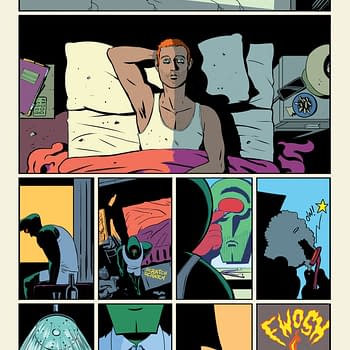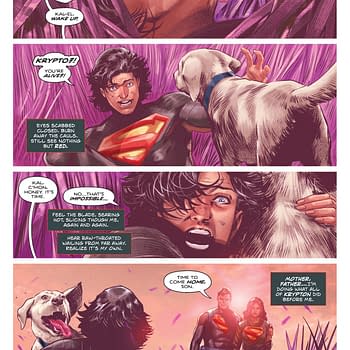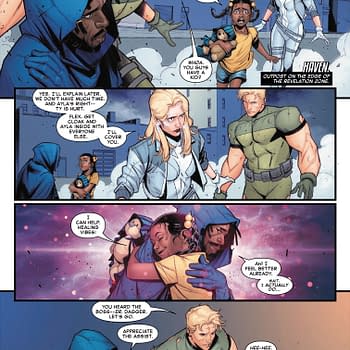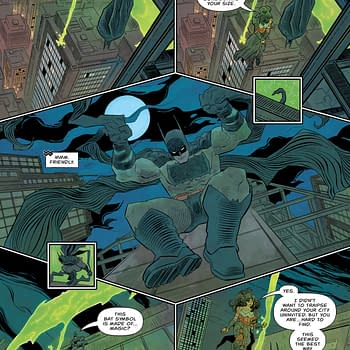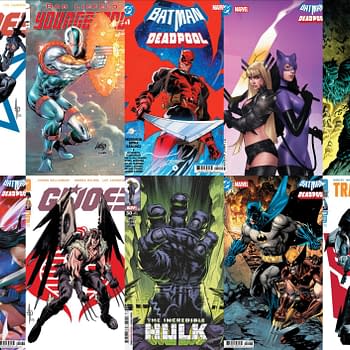Posted in: Comics, Recent Updates | Tagged: Alan Moore, Cabaret Amygdala Presents, Daniel Merlin Goodbrey, digital comics, electricomics, leah moore, mitch jenkins, NESTA, Peter Davidson, Peter Hogan, show pieces, thought bubble, todd klein
A Creator Experiments With Electricomics – Peter Hogan In The Bleeding Cool Interview
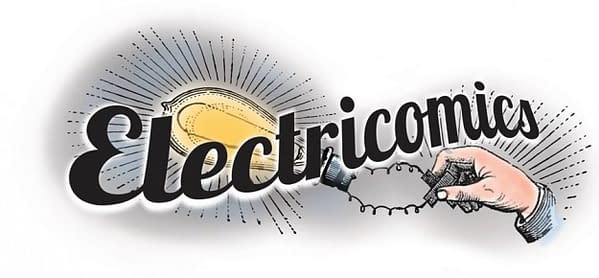
Electricomics sets out to develop an open access toolkit for comic creators to produce digital comics, even if they have no previous experience in the technological aspects of digital comics. Along with the toolkit, which will also hopefully apply to other types of arts-based projects and organizations, such as the creation of interactive archives, Electricomics is creating a pilot set of 4 example comics in an anthology which sets out to display different ways in which the toolkit can be used. Those four comics will be created by Alan Moore and Colleen Doran (Big Nemo), Leah Moore, John Reppion, and Nicola Scott (Sway) Garth Ennis and Peter Snejbjerg (Red Horse), and Peter Hogan and Paul Davidson (Cabaret Amygdala).
The idea, strangely enough, originated as a concept developed for Alan Moore and Mitch Jenkins' short film series Show Pieces, and continues to be part of the universe of The Show, as a "spindle" whereby children read comics from a translucent scroll. The root strangeness of that concept and image isn't far from the kind of lucid creativity that springs up, however, when you get a group of seasoned comics professionals together and pose them with unusual possibilities. They start to want their comics to do things they haven't been able to do before, given the chance, it seems. Following many years as an active comic creator in print, with the occasional experience of digital aspects, Peter Hogan (Tom Strong, Terra Obscura, Resident Alien, The Dreaming, 2000AD) joins us here at Bleeding Cool to talk about the creator's perspective on Electricomics and what the experience has been like for him so far working with Paul Davidson on the horror comic Cabaret Amygdala for the Electricomics app.
Hannah Means-Shannon: Great to meet you at Thought Bubble in November, Peter. What did you find people who came to the Electricomics table to talk were most interested in about the project?

Whereas for me, the most interesting aspect by far is the fact that we have some of the best talent in the industry creating new tales in digital form. I think I'd find that intriguing and exciting even if I wasn't involved myself.
HMS: Do you have previous experience either as a writer or reader with digital comics, or is this a new venture for you?
PH: It's new. For me, if I want to read comics I'd opt for a trade paperback, which has all the strengths of the grammar of comics – the page turnover, the double-page spread and so on – that you lose digitally. I do think there are also real advantages to reading monthly comics in digital form – notably the storage angle, and the fact that the story isn't constantly being interrupted by adverts.
But I've obviously been aware of other stuff too. Geek & Sundry did a kind of motion comic of Resident Alien a few years back via YouTube, and it was obvious that we hit a whole new audience with that, one that wasn't into conventional comics at all. Also, I'd had a few talks with Liam [Sharpe] at Madefire about the possibility of my doing something for them – which got me thinking about the whole digital area in general.
[youtube]http://youtu.be/ZaUqr2GhPKg?list=PL3B7AACC4E950326E[/youtube]
HMS: Did it take much persuasion to get you on board as part of the creative side of the Electricomics team?
PH: No, of course not. Alan [Moore] rang me up soon after he'd had the 'spindle' idea, and basically ranted at me enthusiastically about the whole subject of digital comics and their possibilities for about forty minutes, then asked me if that was something that I might be interested in getting involved with. So I said, 'Alan, you had me at "Hello"…'
This would be three years ago, maybe even four – it took a LONG time for this whole thing to gel together and get funding. Finally, last Spring we got the go ahead to start work on it.
Alan and Leah [Moore] had decided to do an anthology of four short stories, all in different genres, and they asked me to tackle something in the horror line. Which was a bit of a poser for me, as I've always had a bit of problem with supernatural horror, basically because it simply doesn't scare me. Most supernatural horror I just find ludicrous – including the whole area of hell and the devil – and although there are supernatural horror concepts which I think probably have some kind of basis in reality, like ghosts, I don't actually happen to be scared of them myself.
Anyway, Alan explained that what they were looking for was more a horror of unease, and both he and Leah suggested some books for me to read that they felt had that quality, like Charlotte Gilman's The Yellow Wallpaper – which is about someone going mad before your eyes, and is genuinely disturbing – and Robert Aickman's short stories, which are very strange indeed. Alan also suggested the title 'Cabaret Amygala' for it … which to me sounded more like an umbrella concept, like The Twilight Zone. So I suggested we make it 'Cabaret Amygdala Presents', followed by the story title, which in this particular case is called 'Second Sight'.
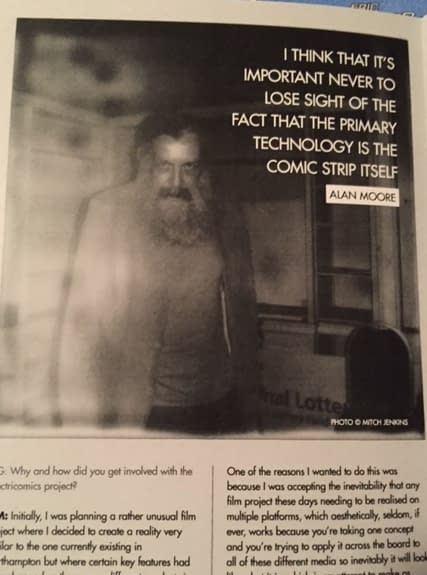
HMS: When you compare your "normal" scripting method for your many comics projects, from Tom Strong to Resident Alien and beyond, did you find yourself scripting differently for Electricomics?
PH: Sure. In some ways it's the same deal, because it's all storytelling, but there are also other aspects that are brand new, because we're trying to do something that actually utilizes digital possibilities. We kept something resembling a page structure just for the sake of our own sanity, but there are important differences. I actually labelled my pages alphabetically rather than numerically, just to suggest to everyone involved that we weren't necessarily being strictly linear with this one.
HMS: Yes, we've heard rumors that you are actually constructing a "choose your own adventure" format for this comic…
PH: It's not QUITE that, though it does include that approach.
Once I started having horror ideas they came thick and fast, but none of them were suitable. Mostly those stories were just too long, but also most of them were pretty conventional in terms of structure. Then I remembered this old EC horror story by Jack Davis called 'Let The Punishment Fit The Crime'. I read it when I was 11 or 12, and it made a big impact on me. It's about some townspeople watching the local kids holding a mock funeral…and through their discussions the reader can piece together what's actually going on is that this is a REAL funeral, because these kids have actually killed someone.
Thinking about it, for me the interesting things were that the Bad Thing has already happened before the story starts, so there's no gore at all and the horror is all in the reader's head – and the reader is at least one step ahead of the townspeople in figuring it all out.
That got me thinking about jigsaw puzzles. You can put together a jigsaw puzzle in any order you like, and whatever order you pick you end up with the same picture. I wondered if you could do that with a story, letting the reader slowly unveil a mystery one piece of information at a time, with the reader controlling the whole process.
Turned out you can't actually do that, because some pages are of necessity more spoiler-heavy than others. So, we've had to guide the flow of it all somewhat, but the reader still gets a certain number of options as to which order to read some of the pages in.
It's still kind of a traditional story at root, has something of the air of EC or a Roald Dahl short story. As to subject matter, I picked a couple of concepts that I personally find kind of disturbing, and linked them together. What those concepts are is what the readers have to discover for themselves.
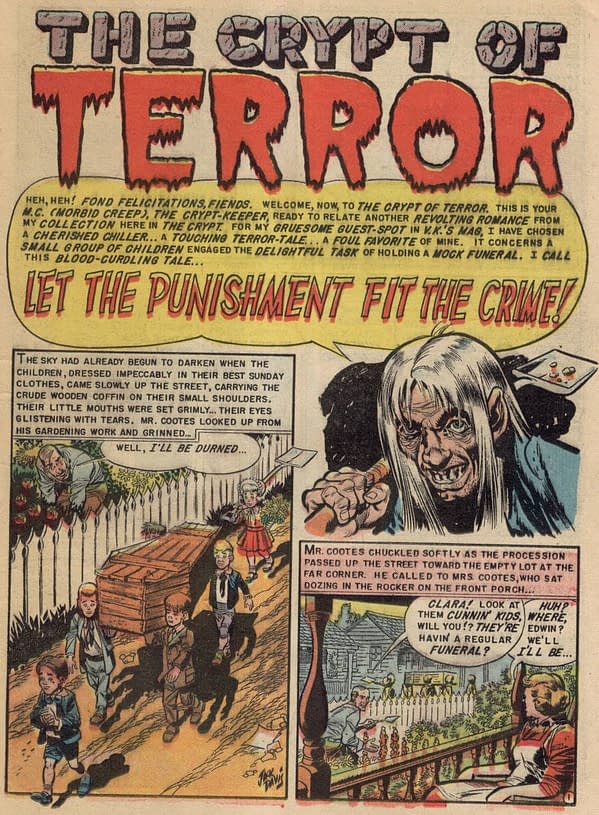
PH: You know, I have absolutely no idea. What happened was that I went to one of the early meetings in Northampton with all the technical guys present, and asked a few questions along the general lines of, 'Can we actually do this thing I've thought of ? If not, how about this other thing?' Which seemed to get them all quite enthused, I think because I was giving them problems to solve.
After that, the finished script contained a lot of technical asides like, 'Here's what we need to make happen at this point'. I was basically being very Jean-Luc Picard, you know – THIS needs to link to THAT in a particular way, and to this OTHER thing in a different particular way, so…Make it so.
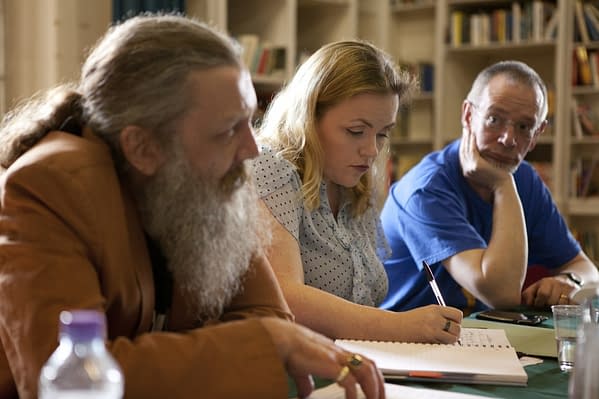
HMS: How do you keep your mind from exploding trying to construct narrative relationships?
PH: Long walks and clean living. But this one was hard, very hard, and probably the most ambitious thing I've ever done. My wife Ellie – who is an excellent editor – helped me thrash out the final structure, but to do it we had to print out the script and physically move stuff around on the carpet till it worked. It was the only way to nail it down.
HMS: Can you tell us about your process working with artist Paul Davidson? What is it you hope to accomplish with the comic?
PH: I'd already pretty much finished the script by the time Paul came on board. So I answered a question or two, but otherwise everything just got routed between us by Leah, who's done an amazing job of pulling the whole anthology together. It all turned out very well indeed, and I'd happily work with Paul again. As to what I'm hoping to accomplish…same as usual, mainly: to entertain, to stimulate. In this case to maybe send some shivers down some spines as well – and if I've actually pulled this trick off, a polite ripple of applause would be nice.

HMS: Because this is a NESTA funded project, I know there will be a lot of documentation of processes required. Do you have to submit your experiences working with these tools as a matter of record? Are you, in a way, a comics guinea pig?
PH: Nobody's asked me to talk about the working process yet, but if they did I'd simply tell them all the stuff I've just told you.
But yes, I guess we're all guinea pigs – except that in our case it's the guinea pigs who are actually driving the experiment, and we're all approaching it from the angle of story, rather than the angle of technology.
HMS: Based on your experience so far, do you think you'll continue scripting digital comics projects in the future as well as print? Do you think working on this new project has expanded your view of comics?
PH: It's certainly been challenging, and I'd definitely attempt another one if we get asked to. I don't think digital is THE future of comics, but it is definitely a part of the future. Perhaps the tricks we've all come up with for these Electricomics stories won't work on EVERY kind of story, but that doesn't really matter. It's still been a very interesting and worthwhile experiment, and it's good to get experimental from time to time.
To read the previous interviews in this series, you can find them here:
*The logo that appears at the beginning of this article is a variant version among several designed by Todd Klein
You can learn more about NESTA and the digital arts fund by following them on Twitter @nesta_uk or the hashtag #artsdigital











